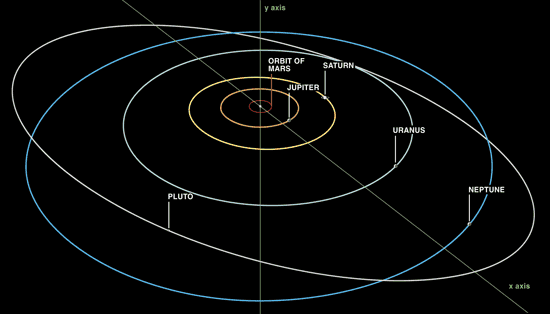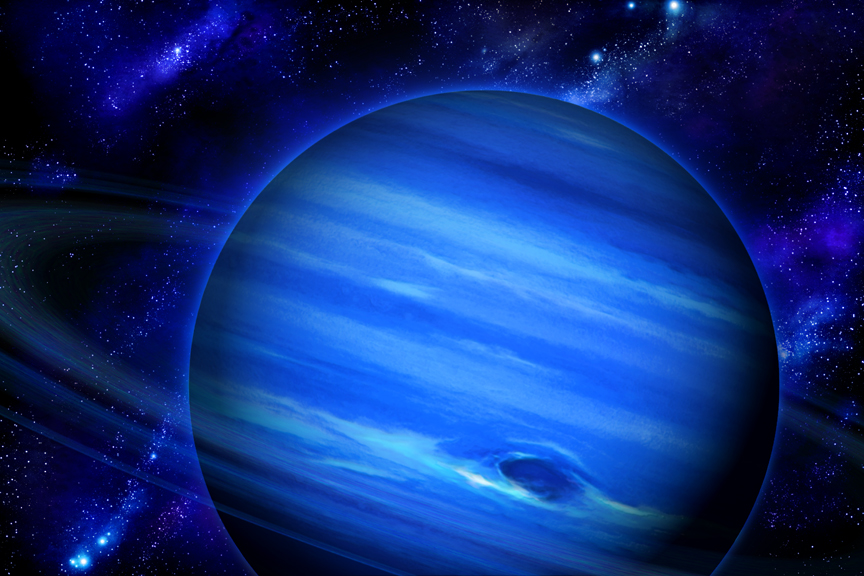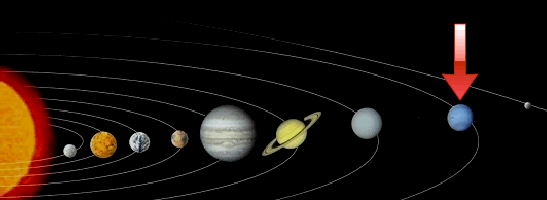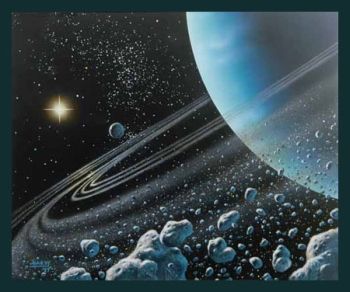How The Universe Began: Big Bang Theory
 The universe started out as a tiny little dot. That little dot had alot of energy inside it. One day, that dot released it's energy. Astronomers called this the Big Bang Theory, which explains how the universe began. Right this moment, the universe is expanding. Because of the expansion, the constant movement of spreading, galactic objects are also moving along. This constant moving of the universe is powered by an energy called the dark energy. Astronomers say that the universe's expansion is accelerating, expanding faster than before. Think of this expansion like an air conditioned room except that the walls of that room is endless and the cool, invisible air is flowing in at an accelerating rate. The air fills the empty room like the universe filling in the empty space that has yet to be occupied. The universe is about 13.8 billion years old.
The universe is mysterious. Our present technology hasn't been able to crack this mystery, yet. Whether the universe is infinite or not and what is outside the universe are questions that astronomers still not know. The universe is like a code and our future generations of astronomers may be able to crack it with their knowledge and advanced technology.
The universe started out as a tiny little dot. That little dot had alot of energy inside it. One day, that dot released it's energy. Astronomers called this the Big Bang Theory, which explains how the universe began. Right this moment, the universe is expanding. Because of the expansion, the constant movement of spreading, galactic objects are also moving along. This constant moving of the universe is powered by an energy called the dark energy. Astronomers say that the universe's expansion is accelerating, expanding faster than before. Think of this expansion like an air conditioned room except that the walls of that room is endless and the cool, invisible air is flowing in at an accelerating rate. The air fills the empty room like the universe filling in the empty space that has yet to be occupied. The universe is about 13.8 billion years old.
The universe is mysterious. Our present technology hasn't been able to crack this mystery, yet. Whether the universe is infinite or not and what is outside the universe are questions that astronomers still not know. The universe is like a code and our future generations of astronomers may be able to crack it with their knowledge and advanced technology.
The Dwarf Planet: Pluto
 Pluto is one of the dwarf planets in our solar system. Pluto is located in the kuiper belt, similar to the asteroid belt. (The kuiper belt is a belt of asteroids that is after Neptune. It surrounds the 8 planets and the sun.) Instead of being aligned with the other planets' orbit, Pluto's orbit is tilted. It takes this planet 248 Earth days to complete an orbit around the sun.
Pluto is made of mostly ice and rocks. Astronomers believe that its core is made of rocks and its mantle is ice. Pluto has a thin atmosphere when it goes near the sun, but the atmosphere disappears when Pluto is not near the star. The reason for this is because when Pluto goes near the sun, some of the ice on the surface melts and evaporation occurs. When Pluto is far away, its surface becomes ice again.
Pluto has 5 known satellites: Charon, Styx, Hydra, Nix, and Kerberos. Charon is the largest and most inner moon. Kerberos and Styx are the smallest moons and are the outer moons.
Pluto is one of the dwarf planets in our solar system. Pluto is located in the kuiper belt, similar to the asteroid belt. (The kuiper belt is a belt of asteroids that is after Neptune. It surrounds the 8 planets and the sun.) Instead of being aligned with the other planets' orbit, Pluto's orbit is tilted. It takes this planet 248 Earth days to complete an orbit around the sun.
Pluto is made of mostly ice and rocks. Astronomers believe that its core is made of rocks and its mantle is ice. Pluto has a thin atmosphere when it goes near the sun, but the atmosphere disappears when Pluto is not near the star. The reason for this is because when Pluto goes near the sun, some of the ice on the surface melts and evaporation occurs. When Pluto is far away, its surface becomes ice again.
Pluto has 5 known satellites: Charon, Styx, Hydra, Nix, and Kerberos. Charon is the largest and most inner moon. Kerberos and Styx are the smallest moons and are the outer moons.
 In the 1900s, astronomers classified Pluto as a planet. But there was a problem. There were other space objects that were even bigger than Pluto. There were heated debates about whether Pluto is a planet or not. But in 2006, Pluto was classified as a dwarf planet. Pluto has no rings and it is about 5.8 billion km. away from the sun.
In the 1900s, astronomers classified Pluto as a planet. But there was a problem. There were other space objects that were even bigger than Pluto. There were heated debates about whether Pluto is a planet or not. But in 2006, Pluto was classified as a dwarf planet. Pluto has no rings and it is about 5.8 billion km. away from the sun.
Neptune
 Neptune is the eighth planet from the sun. It is the last planet in our solar system. Neptune is considered a Gas Giant and an Ice Giant. It is the most dense out of all the Gas Giant planets. Neptune's atmosphere is made up of hydrogen and helium along with hydrocarbons, fuel that humans use, and maybe even nitrogen. Because it is the last planet from the sun, Neptune has the coldest outer atmospheric temperature out of the eight planets.
Neptune has a place in it's southern hemisphere called the Great Dark Spot which is similar to Jupiter's Great Red Spot. The Great Dark Spot, like the Great Red Spot, has wind speeds that can reach as high as 2,100 km/h. Five years later after the discovery of the Great Dark Spot, the Hubble Telescope found another cyclone, known as the Scooter, that moved even faster than the spot. It was located in the planet's northern hemisphere. Like Uranus, Neptune is consisted of ice and rocks. Astronomers believe that there are various types of methane that makes up the blue color of Neptune.
Neptune is the eighth planet from the sun. It is the last planet in our solar system. Neptune is considered a Gas Giant and an Ice Giant. It is the most dense out of all the Gas Giant planets. Neptune's atmosphere is made up of hydrogen and helium along with hydrocarbons, fuel that humans use, and maybe even nitrogen. Because it is the last planet from the sun, Neptune has the coldest outer atmospheric temperature out of the eight planets.
Neptune has a place in it's southern hemisphere called the Great Dark Spot which is similar to Jupiter's Great Red Spot. The Great Dark Spot, like the Great Red Spot, has wind speeds that can reach as high as 2,100 km/h. Five years later after the discovery of the Great Dark Spot, the Hubble Telescope found another cyclone, known as the Scooter, that moved even faster than the spot. It was located in the planet's northern hemisphere. Like Uranus, Neptune is consisted of ice and rocks. Astronomers believe that there are various types of methane that makes up the blue color of Neptune.
 It takes 18 hours for Neptune's equator to rotate on its axis. It takes Neptune about 165 years to complete an orbit around the sun. Neptune's tilt is almost the same as Earth's and Mar's tilt which is about 28.3 degrees. Due to the same tilt degree as Earth, this planet also has seasons, but it takes about 40 years for a season to change into another. ( 165 years divided by 4 seasons is about 40 years for every season.) Neptune is about 4.503 million km. away from the sun.
Neptune's name came from the Roman Mythology, the God of the Sea, Neptune. Neptune has 14 satellites and few, thin planetary rings.
It takes 18 hours for Neptune's equator to rotate on its axis. It takes Neptune about 165 years to complete an orbit around the sun. Neptune's tilt is almost the same as Earth's and Mar's tilt which is about 28.3 degrees. Due to the same tilt degree as Earth, this planet also has seasons, but it takes about 40 years for a season to change into another. ( 165 years divided by 4 seasons is about 40 years for every season.) Neptune is about 4.503 million km. away from the sun.
Neptune's name came from the Roman Mythology, the God of the Sea, Neptune. Neptune has 14 satellites and few, thin planetary rings.
Uranus
 Uranus (lol) is the seventh planet from the sun. Like Saturn, it is shaped like an oval, but Uranus is tilted completely on its sides. It's like having humans lay down on the ground and then telling them to roll on their sides around and around. Uranus is considered an Ice Giant, but it has hydrogen and helium as its atmosphere just like the other two planets, Jupiter and Saturn. Uranus' atmosphere also has other substances like methane and hydrocarbon which is used as fuels on Earth. Unlike the other planets, Uranus does not have a molten, hot, lava mantle, but it has a mantle that has ice and rocks. This planet's core is also different from the other planets' because its core is made out of ice which is similar to its mantle. Uranus has the coldest atmosphere out of the eight planets, probably because of the different substances that its atmosphere contains of. Uranus has five thin rings made of rocks and dust particles.
Uranus takes eighty-four Earth years to complete a whole rotation around the sun. Its tilt is about ninety-eight degrees. Because Uranus is rolling on its side, the pole at the end of the side that faces the sun, gets forty-two years of sunlight, while the other pole at the other side, gets forty-two years of complete darkness. Its distance from the sun is about 2.877 billion km. away from the sun.
Uranus (lol) is the seventh planet from the sun. Like Saturn, it is shaped like an oval, but Uranus is tilted completely on its sides. It's like having humans lay down on the ground and then telling them to roll on their sides around and around. Uranus is considered an Ice Giant, but it has hydrogen and helium as its atmosphere just like the other two planets, Jupiter and Saturn. Uranus' atmosphere also has other substances like methane and hydrocarbon which is used as fuels on Earth. Unlike the other planets, Uranus does not have a molten, hot, lava mantle, but it has a mantle that has ice and rocks. This planet's core is also different from the other planets' because its core is made out of ice which is similar to its mantle. Uranus has the coldest atmosphere out of the eight planets, probably because of the different substances that its atmosphere contains of. Uranus has five thin rings made of rocks and dust particles.
Uranus takes eighty-four Earth years to complete a whole rotation around the sun. Its tilt is about ninety-eight degrees. Because Uranus is rolling on its side, the pole at the end of the side that faces the sun, gets forty-two years of sunlight, while the other pole at the other side, gets forty-two years of complete darkness. Its distance from the sun is about 2.877 billion km. away from the sun.
 Uranus was named after the Greek deity of the sky. Jupiter, the fifth planet, was named after Zeus. (In Roman mythology, Zeus is called Jupiter.) Then Saturn, the sixth planet, was named after Cronus, the father of Zeus. Now, the seventh planet was named Uranus, the father of Cronus and grandfather of Zeus. It's kind of weird about how the astronomers named these three planets.
Uranus was named after the Greek deity of the sky. Jupiter, the fifth planet, was named after Zeus. (In Roman mythology, Zeus is called Jupiter.) Then Saturn, the sixth planet, was named after Cronus, the father of Zeus. Now, the seventh planet was named Uranus, the father of Cronus and grandfather of Zeus. It's kind of weird about how the astronomers named these three planets.
 The universe started out as a tiny little dot. That little dot had alot of energy inside it. One day, that dot released it's energy. Astronomers called this the Big Bang Theory, which explains how the universe began. Right this moment, the universe is expanding. Because of the expansion, the constant movement of spreading, galactic objects are also moving along. This constant moving of the universe is powered by an energy called the dark energy. Astronomers say that the universe's expansion is accelerating, expanding faster than before. Think of this expansion like an air conditioned room except that the walls of that room is endless and the cool, invisible air is flowing in at an accelerating rate. The air fills the empty room like the universe filling in the empty space that has yet to be occupied. The universe is about 13.8 billion years old.
The universe started out as a tiny little dot. That little dot had alot of energy inside it. One day, that dot released it's energy. Astronomers called this the Big Bang Theory, which explains how the universe began. Right this moment, the universe is expanding. Because of the expansion, the constant movement of spreading, galactic objects are also moving along. This constant moving of the universe is powered by an energy called the dark energy. Astronomers say that the universe's expansion is accelerating, expanding faster than before. Think of this expansion like an air conditioned room except that the walls of that room is endless and the cool, invisible air is flowing in at an accelerating rate. The air fills the empty room like the universe filling in the empty space that has yet to be occupied. The universe is about 13.8 billion years old. 




